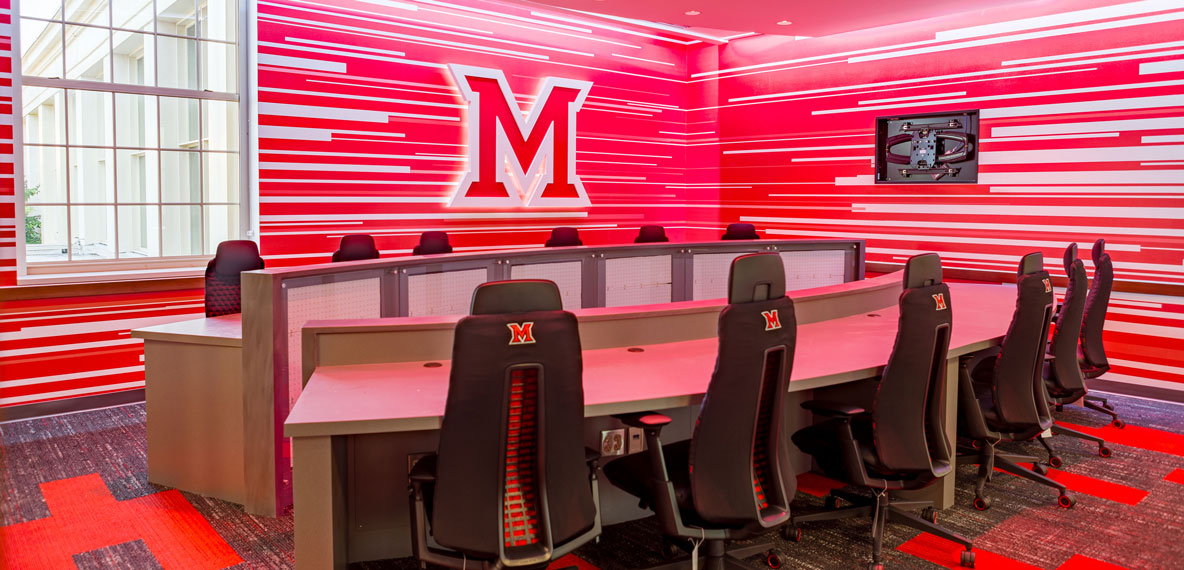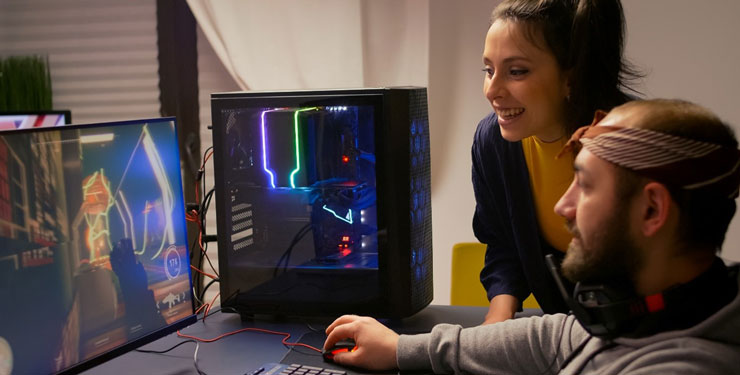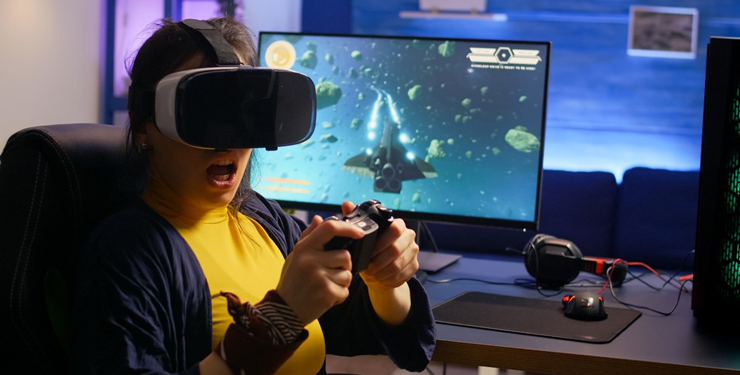
Designing Spaces for Esports and Video Gamers

The full higher education experience is more than classroom lectures. Socializing, attending sports events, joining clubs or student government, and building lifelong relationships contribute to a robust college life. But for students who do not participate in these “traditional” social activities, these developmental years may be spent largely alone in a dorm room, resulting in semi-isolation that deprives them of the vital interactions with fellow students and other campus resources to create the collegiate experience.
One way for colleges to engage socially withdrawn students is to provide options for interaction through gaming and esports. Gaming and esports are an exploding industry; the latter is projected to reach about $1.62 billion in revenue by 2024. As the gaming and esports industries have gained ground among young players and spectators, colleges are responding with both degree programs and designated spaces that bring gamers together on campus to play in a group setting. When designed to facilitate real-life interaction and collaboration, these gaming and esports-specific spaces can be the catalyst for students who might otherwise not participate in events or engage in university life.
Scope of the industry
Gaming and esports are huge industries and continue to gain traction as legitimate skill-building activities and revenue generators. But first, it is important to define the two: gaming is a broad term that ranges from iPhone apps like Candy Crush to immersive, virtual world-building series like Minecraft. Games cross over into esports when the play becomes competitive, whether the players are individuals or groups. Esports viewership was estimated at 454 million in 2019 and is growing at a rate of 9% a year to an expected viewership of 646 million by 2023, according to market analysts at Business Insider.
Colleges and universities have noticed the boom: more than 200 now have programs related to esports, according to a research brief by The Council of Independent Colleges. Similarly, students who are adept at gaming are seeking programs tailored to careers in in this field and are seeking scholarships to attend schools that provide formal college degrees.
Several organizations such as the Entertainment Software Association and the IGDA Foundation offer scholarships for students interested in gaming and esports careers. Taking a further step and establishing dedicated centers on campus for gaming and esports may offer an appeal broader than the students focused on a career in game design or business.
Benefits of gaming and esports
Within a higher education setting, gaming and esports can attract otherwise marginalized or nonathletic students, build physical activity into students’ routines, and help students hone social and career skills. Game situations present real-world scenarios in which students must learn to effectively communicate, collaborate, and solve problems. Students may acquire these skills without conscious acknowledgement—all part of gamification—or activities specifically designed to achieve motivation and engagement. These skills can be applied to other aspects of student life on campus and translate into foundational and transformative career skills.
Gaming can create more well-rounded students. Students who take part in gaming or esports often have improved mental stamina for long-term activities and improved three-dimensional visualization abilities. A 2015 study published in Nature Research found that those who were prolific in gaming demonstrated improved cognitive function, perception, dexterity, and fine motor control.
At the same time, becoming active in esports can increase engagement across all activities. Students who participate in esports have higher grades and are more likely to complete their chosen degree programs, according to the National School Boards Association. NSBA reported that among high school students who joined esports groups, attendance rose 10% and grade point averages increased by 1.7 points.
Perhaps now more than ever before, as students come out of the Covid-19 pandemic, they want a shared experience and connection to their peers. A well-designed esports or gaming center can create that sense of belonging, community, and dynamic interaction.
An esports space will fundamentally draw students together to connect and improve individual student experience. Actual esports or gaming play remains the same whether it’s in an isolated area or in a shared arena-like space. The difference in the latter is the interaction with other students; that connection makes an esports space at a university intrinsically valuable.
Space design
More higher education institutions are acknowledging that gaming and esports should have a dedicated presence on campus. But creating a successful space for students is not as simple as just designating a gaming area in a conference room or computer lab. The key is fostering student interaction through a suite of spaces and making the space a destination.
A successful space incorporates theatrical elements like a stage for players and a spectator area, while also reserving space for strategy discussion, and deconstructing recent games. The esports space is high-energy and acts as an event space for game play. At the same time, the space will incorporate areas for quiet discussion and collaboration, to strategize for the next tournament, and even as a study lounge when games are not scheduled.
Gaming and esports spaces retain some elements that are similar to home play—dim lighting, blacked-out windows, and comfortable seating. But the stakes are much higher in the shared area with game feeds to large screens, spectator seats, and gamers seated facing opponents. For colleges and universities with space to accommodate, the ideal dedicated area includes a gaming theater, offices, lounges, and practice and casting rooms.
In this design, the competition space resembles a theater and includes high-end lighting and audiovisual equipment for streaming games to viewers, as well as a casting room for commentators to add their take on play in real time. While players are locked in battle, in an adjacent practice room another team plans its game strategy using a whiteboard to plot moves as they practice the game. The space facilitates discussion and comfortable training play.
Another space or interspersed spaces function as lounge areas where teams and viewers can relax and connect. Additionally, they can serve as study areas during off hours. When well-designed, each of the spaces can serve a multipurpose use on campus, including academic use for competition and practice spaces. Game theory, gamification, and digital media classes could be held in the space during instructional hours.
Location, location, location
Esports and gaming centers can be situated in several places on campus, both physically and organizationally, depending on the anticipated use or relevance to academic programs. For institutions with esports programs, the facility may be housed with athletics, student recreational activities, or near related academic programs. Choosing a home for these programs should be carefully considered by the university’s internal organization; administrators should take into account the long-term goals for the program at the institution.
It’s also important to note that esports do not necessarily require a large arena. Programs can be scalable, depending on investment, student enrollment and interest, or physical footprint. The program can begin with a single multiuse space. A minimal design requires only an open space that can be portioned into specific uses through furniture or other design elements. The space also could double as a lounge or study space while not in use for gaming.
It's all about connections
Gaming and esports continue to gain popularity. In higher education, these virtual worlds can serve as a conduit to real-world outcomes: connecting students on campus, prompting them to excel academically, and assisting them in building career and personal skills. Space design can facilitate these benefits, provided that the right elements are incorporated through dynamic visuals, use of space, technology integration, and lighting.
An esports and gaming space that encourages social connectedness, promotes collaboration, fosters problem-solving, and uses a strategic approach to success can help students gain confidence and build valuable skills that will benefit them beyond graduation.
Sidebar: Gaming and career paths
There’s no question gaming and esports can build skills and guide students toward certain career paths. Some gaming-driven careers may have a straightforward connection, and others may seem like a left turn. Here are a few career paths reported to have been aided by skills in gaming or esports:
- Professional esports player or coach
- Computer design
- Software or game design
- 3-D visualization/design
- UX design
- Data analytics
- Game theory
- Game business management.
Gaming and esports skills have an even broader reach beyond working in careers related to either. Students spend time polishing skills that apply to many careers outside the obvious, including:
- Architecture that relies on 3-D visualization and building designs in 3-D modeling software
- Automotive design
- Industrial design
- Manufacturing or construction that can use 3-D models and augmented reality to translate digital into physical builds
- Medical professions that require fine motor skills and visualization
- STEM subjects, because of the critical thinking, analysis, systematic approach, process-based discovery and problem solving needed in some games
- Marketing and advertising skills through use of social media channels and creation of online presence
- Augmented and virtual reality
Providing students with spaces to develop gaming and esports skills and experience will create widespread career opportunities for generations to come.
This article is published by American School and University.
Author
Content Type
Published Articles
Date
November 01, 2021
Market
Topic
Esports



